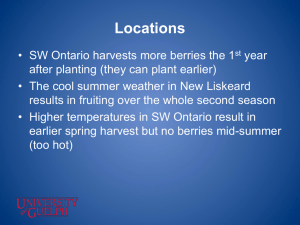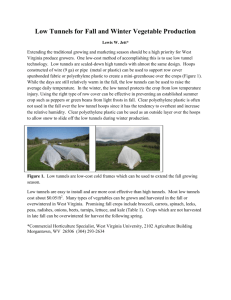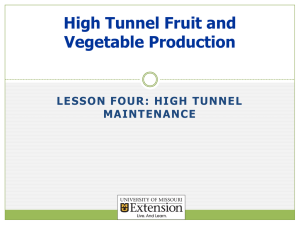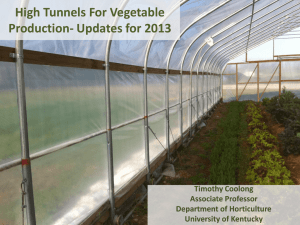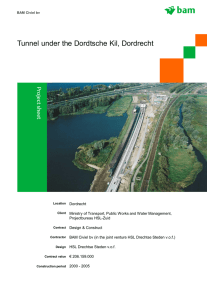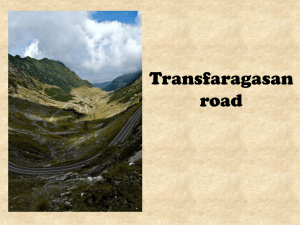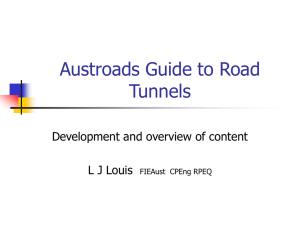High Tunnel Selection and Construction
advertisement
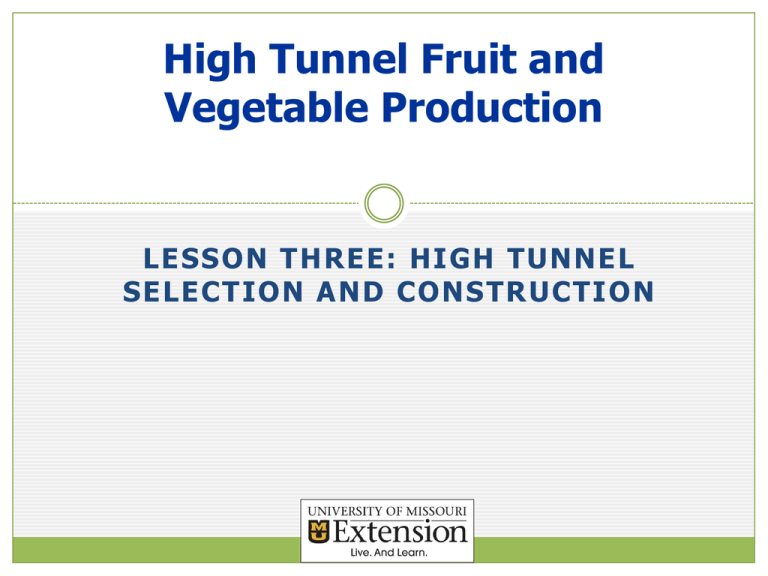
High Tunnel Fruit and Vegetable Production LESSON THREE: HIGH TUNNEL SELECTION AND CONSTRUCTION Interest Approach Different growing situations may require different types of high tunnels. Why do each of these growers have different needs? Scenario 1: Mr. Turner enjoys growing mostly tomatoes. Scenario 2: Mrs. Mills lives in a high snowfall area. Scenario 3: Mr. Leonard grows in multiple high tunnels spread out over a large area of land. Objectives Discuss several issues that should be considered prior to high tunnel construction. Recognize the different sizes and types of high tunnels used in crop production. Identify the major components of a high tunnel and their functions. Outline the high tunnel construction process. High Tunnel Construction: Issues to Consider • • • • • Location Budget Potential crops Expansion Market area • • • • • Orientation Airflow Access Irrigation Drainage High Tunnel Construction: Issues to Consider Shade Greatly reduces the effectiveness of a high tunnel since it limits light. Space Allow two times the height of an obstacle away from the high tunnel Example: A 25 ft. tree should be how far away from the high tunnel? Answer: 50 ft. High Tunnel Construction: Issues to Consider Multiple tunnels: East-west orientation: spacing among the tunnels needs to be twice the height of the tunnels. North-south orientation: spacing can be 4 feet among them. High Tunnel Sizes and Types Manufactured versus Homemade The most important factor to consider is your budget. Homemade are usually less expensive and often less permanent than commercially manufactured structures. Be sure to choose structures that are made of materials with the lowest environmental impact. High Tunnel Sizes A typical tunnel is 15 to 30 feet wide and 60 to 96 feet long. Wide tunnels have the advantage of being easier to manage. In most cases, tunnel width should not exceed 30 feet. Tunnels exceeding 96 feet in length pose some potential problems. Ventilation Temperature variability Two Main Types of High Tunnels Single-bay high tunnels: free standing, or not connected to another high tunnel. Multi-bay high tunnels: two or more tunnels connected along the sides. Also referred to as gutter connected. Shape The shape of the high tunnel will affect the performance. Single-bay high tunnels come in two primary shapes: Quonset (Hoop) Gothic Arch Quonset Quonset Lower cost Unheated Quonset structures can also serve as cold frames for overwintering nursery stock. Multi-bay Quonset high tunnels cover large areas and, per bay, are relatively inexpensive. Gothic Arch Gothic Arch Readily sheds snow 15 % greater load-carrying capacity than a Quonset Taller sidewalls more usable space along the sides for working comfort, crop production and growth, and equipment access. Height Great for trellised crops such as tomoatoes Better ventilation Major Components of High Tunnels A. Rib, Hoop, Arch, Bow B. Purlin, Ridgepole C. End Wall D. Hip Board E. Side Wall F. Baseboard High Tunnel Construction Process Build and secure the frame Cover the frame It is best to choose a calm, warm day and let the plastic warm up so it will be easier to handle and stretch more than if it is cold. End walls Zippered ends or a large door must be constructed in the end walls to permit ventilation in the summer as well as entrance and exit of equipment. Sides: Roll Up versus Roll Down High tunnel sides may roll up or roll down to open. Roll down sides provide protection to plants when only rolled partially down, which can prevent abrasions to the plants. The abrasions then allow entry for diseases and pests. Manual versus Automatic Manual: Opened with a screw level Lower cost Higher labor Automatic: Motorized Higher cost Lower labor Motorized sidewalls are activated by a thermostat inside the high tunnel and the vents open and close automatically within preset temperature ranges. Be Aware! The advantage of motorized sidewalls is that someone does not need to be present for the system to work. If the system fails to work, heat could build up inside the tunnel and possible plant or crop loss could result. If an automated system is present, then a buzzer or phone alarm hooked up to a thermostat inside the high tunnel might prevent a catastrophe. Tools for Construction Level Transit & Rod String Tape Measure Sledge Hammer Standard Hammer Staple Gun & Staples Shovels Wrenches—5/8; 9/16; ½; 7/16; 3/8 Cordless Drill & Bits (several) Center Punch Tin Snips Skid Steer or Tractor with Loader Hay Frame Wagon Additional materials required: 2 x 6 Baseboards –Western cedar or treated wood = to length of tunnel and framing materials for end walls. Scenarios Let’s look back at those scenarios and see which type of high tunnel is most appropriate. Scenario 1: Mr. Turner enjoys growing mostly tomatoes. Answer: Quonset (trellised) Scenario 2: Mrs. Mills lives in a high snowfall area. Answer: Gothic (snow falls off more easily) Scenario 3: Mr. Leonard grows in multiple high tunnels spread out over a large area of land. Answer: Quonset (less expensive and simpler construction when installing multiple high tunnels) Review There are several issues that should be considered prior to high tunnel construction. Different sizes and types of high tunnels used in crop production are available. High tunnels can be prefabricated or homemade, each have their own advantages.

